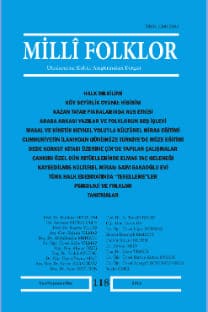EVLİYÂ ÇELEBİ SEYAHATNÂME'SİNDE AYASOFYA CAMİİ VE EKFRASTİK YAKLAŞIM
Antik Yunan ve Roma kültüründe retorik uygulamalarının bir parçası olan "ekfrasis" en temel anlamıyla, görsel bir nesnenin sözle ifade edilmesidir ve zaman içinde yazınsal bir araç hâline gelmiştir. Homeros'un İlyada'sında Akhilleus'un kalkanının tasvir edilişinden bu yana ekfrasis, yazarların, tarihçilerin, sanat eleştirmenlerinin sıklıkla başvurduğu bir yazınsal uygulamadır. Görsel sanat eserlerinin şiir, roman gibi kurmaca metinler aracılığıyla tasviri olarak uygulandığı gibi; tarih, sanat eleştirisi ve seyahat alanında yazılan düzyazı metinlerinde de karşımıza çıkar; yazarın tasvir ettiği nesneyi ele alış biçimini çözümlemek için incelenir. Ekfrasis incelemeleri, yazarın nesnellik ve öznellikle kurduğu ilişkinin, dışavurduğu öznelliğinin yapıtaşlarının yazınsal unsurlar aracılığıyla saptanmasına imkân verir. Bu çalışmada seyyah-yazar Evliyâ Çelebi'nin Seyahatnâme'de ayrıntılı olarak tasvir ettiği Ayasofya Camii'ni nasıl bir ekfrastik yaklaşımla ele aldığı incelenecek, bilhassa estetik değerlendirmesine etki eden öznel faktörlerin yazı pratiğinde nasıl ortaya çıktığı irdelenmeye çalışılacaktır. Özünde dilsiz nesneyi konuşturma eylemi olan ekfrasis, Evliyâ Çelebi'nin temsilinde nasıl bir kurmaca diline işaret eder? Bu dilin yarattığı orijinal nesneden bağımsız yeni görüntü, başka bir deyişle Evliyâ'nın oluşturduğu Ayasofya imgesi nasıl bir imgedir? Evliyâ Çelebi'nin ekfrastik anlatısında gözlemlenen kişisel beğeninin ve kültürel konumlanmanın yansıması estetik bakışa nasıl bir etkide bulunur? Yazarın ekfrastik uygulamasında kendisini olduğu kadar hedeflediği okuyucu kitlesini de nasıl konumlandırdığı incelenmelidir. Bu sorgulama Seyahatnâme yazarının estetik bakışının nasıl şekillendiğini gözlemlemeye ve metnin bu konu üzerinden saptanacak yeni yazınsal özelliklerini ortaya koymaya yönelik bir yaklaşımın modeli olmayı hedeflemektedir. Sosyal bilimlerin çeşitli alanlarına inceleme konusu olmuş Seyahatnâme'nin kurmaca disiplini içinde daha kapsamlı değerlendirilebilmesine imkân sağlayan "ekfrasis" meselesi, görsellik ve yazı ilişkisine dayandığı için Seyahatnâme çalışmalarına yeni bir disiplinlerarası bakış kazandıracaktır.
Hagia Sophia Mosque and Ekphrastic Approach in Evliyâ Çelebi's Seyahatnâme (The Book of Travels)
As a part of the ancient Greek and Roman rhetorical practices, "ekphrasis" basically means the verbalisation of a visual object, and it has become a literary tool in time. Since the description of Achilles' shield in Homer's İlliad, ekphrasis has been a frequently used literary practice which writers, historians and art critics apply. Ekphrasis can be applied as the description of visual art objects through the fictional forms such as poetry and novel as well as it occurs in the prose concerning history, art criticism and travelogues; it is studied in order to analyse writer's handling with the description of the object. Ekphrasis studies enable to capture the writer's relationship between objectivity and subjectivity, the elements of his/her expressed subjectivity, through literary tools. This study will examine Evliyâ Çelebi's ekphrastic approach in describing Hagia Sofia Mosque in Seyahatnâme (The Book of Travels), especially focusing on how the subjective factors determining the writer's aesthetic appreciation occur in his literary practice. What kind of a fictive language does ekphrasis, which is essentially the act of making the silent image talk, show in Evliyâ Çelebi's representation? What are the characters of the new image created by this language, which is independent from the original object, in other sense the Hagia Sophia image of Evliyâ's? How does the reflection of personal taste and cultural positioning affect aesthetic view of Evliyâ Çelebi's ekphrastic narrative? As well as how the writer positions himself it should also be examined how the writer positions his aimed reader. This questioning aims to observe how the aesthetic view of Seyahatnâme's author takes shape and to be a model of an approach to put forth the new literary qualities of Seyahatnâme's in the light of ekphrasis study. The problem of "ekphrasis" enables Seyahatnâme which has been already a study topic for various social sciences, to be evaluated in the discipline of fiction more widely. As the issue concerns basically the relationship between visuality and writing, it would bring a new interdisciplinary approach to Seyahatnâme studies.
___
Akyol, Ercan. "Seyahatnâme'deki Ayetlerin İş- levleri Üzerine", Millî Folklor, 92, 2011: s.53 57.
Bitik, Başak Öztürk. "Evliyâ Çelebi Seyahatnâme'sinde Cadı, Obur, Büyücü Anlatıları ve Kurgudaki İşlevleri", Millî Folklor, 92, 2011: s.64-71.
Evliyâ Çelebi. Seyahatnâme 1. Cilt. Haz. Robert Dankoff, Seyit Ali Kahraman ve Yücel Dağlı. İstanbul: YKY, 2006.
Kripokavic, Maria. (ed.) The Balkans in Travel Writing. Newcastle upon Thyne: Cambridge Scholars Publishing, 2015; Slavcho Kovilovski, "Patopisot 'Beleshki od moeto patuvanje po Tetovsko' od 1891/91 od Andrej Stojanov," Filoloshki studii, Skopje, 11, 2013: ss. 109-121.
Salazar, Joseph-Philippe. "Beyond Apologetics: Mythology, Rhetoric and The Other in Early Eighteenth-Century France", Rhetoric,
Scripture and Theology: Essays from the 1994 Pretoria Conference. Stanley E. Porter, Thomas H. Olbricht (ed.) Bloomsbury T&T Clark: 1996: s.175.
Schibille, Nadine. Hagia Sophia and The Byzantine Aesthetic Experience. Ashgate, 2014:s.15. Sumi, Akiko Motoyoshi. "Description in Classical Arabic Poetry: Wasf, Ekphrasis, and Interarts Theory", Brill Studies in Middle Eastern Literatures, Supplements to the Journal of Arabic Literature, 25, xvii, Leiden ve Boston: Brill, 2004: s.251.
Tezcan, Nuran "Evliya Çelebi'nin Freng-pesend Resim Tutkusu", Evliya Çelebi : Voyageur Ottoman du XVIIe Siécle et L'europe de son Temps., Evliyâ Çelebi et l'Europe Le « Frengistân » Paris - Institut National des Langues et Civilisations Orientales (INALCO) Cahiers balkaniques 41, 2013: ss.27-42.
